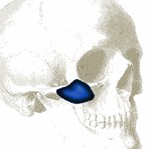
There are several types of implants for the orbital rim. Some extend from the orbital rim towards the nose and down into the tear trough, some extend out from the rim to the cheeks, and others connect the orbital rim to the outer corner of the eye. Pre-formed orbital rim implants are currently available in solid silicone as well as polyethylene. (Medpor) Implants can also be hand carved out of a block or sheet of Gore-tex. (PTFE) I do not believe that the material used makes any difference. It is more important to have the right shape implant in good position than anything else.
Orbital rim implants are best placed through a lower eyelid incision directly onto the bone. This is an obvious way to go if the patient needs skin removed from the lower eyelid as well. It is possible to place them through the inside of the eyelid (transconjunctival approach) but this is more difficult. Lifting up the periosteum of the bone is important so that a cuff of tissue can be used to cover a part or all of the implant. Bringing tissue back up over the implant is important to prevent the edges of the implant from being visible. This is particularly important in those people with thin lower eyelid skin, which seems to be most people who have bone deficiencies in this area. I always secure the implant to the bone with small tiny screws so that it will never move. You will always be able to feel where the implant is as there is little tissue between the implant and the skin in the eyelid area. Most importantly, you just don’t want to be able to see them through the skin. Often I will place a strip of fat or transpose lower orbital fat over the implant to get better coverage.
The key to a good result with orbital rim implants, with or without a cheek extension, is to not overdo it. The improvement is better to be subtle and not dramatic. It doesn’t take very much implant thickness, just a few millimeters, to make a real visible change in the eye area. Large orbital rim implants, while producing better correction, are often visually detectable and, at the least, very palpable.
Because adjusting an orbital rim implant is like repeating the original surgery in its entirety (reopening the whole lower eyelid), I prefer a dual implant approach to the orbital rim. One implant across the orbital rim (placed through the lower eyelid) and a cheek implant placed high up to the orbital rim, touching its edges. This way adjustment of the implants may be easier, particularly when they become scarred into place.
Dr. Barry Eppley
Indianapolis, Indiana


